
Unit 5 Assignments
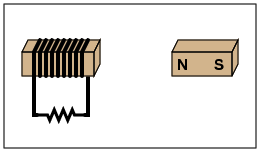
Electromagnets
MS-PS2-3
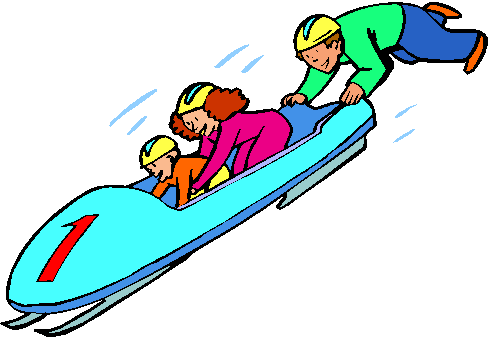
Gravity
MS-PS2-4

Energy
MS-PS3-2
 |
Unit 5 Assignments |
 Electromagnets MS-PS2-3 |
 Gravity MS-PS2-4 |
 Energy MS-PS3-2 |
|
Force Fields: Static
Electricity & Magnetism |
| MS-PS2-5.
Evidence Statement Conduct an investigation and evaluate the experimental design to provide evidence that fields exist between objects exerting forces on each other even though the objects are not in contact. Packet [Clarification Statement: Examples of this phenomenon could include the interactions of magnets, electrically-charged strips of tape, and electrically-charged pith balls. Examples of investigations could include first-hand experiences or simulations.] [Assessment Boundary: Assessment is limited to electric and magnetic fields, and limited to qualitative evidence for the existence of fields.] |
|
MS-PS2-3
Evidence Statement Ask questions about data to determine the factors that affect the strength of electric and magnetic forces. Packet [Clarification Statement: Examples of devices that use electric and magnetic forces could include electromagnets, electric motors, or generators. Examples of data could include the effect of the number of turns of wire on the strength of an electromagnet, or the effect of increasing the number or strength of magnets on the speed of an electric motor.] [Assessment Boundary: Assessment about questions that require quantitative answers is limited to proportional reasoning and algebraic thinking.] |
| The concept that, when
two objects interact, each one exerts a force on the other that can
cause energy to be transferred to or from the object (PS3.C as in
MS-PS3-2) can connect to the idea that forces that act at a distance
(electric and magnetic) can be explained by fields that extend through
space (PS2.B as in MS-PS2-5). These ideas also connect to the concept
that electric and magnetic (electromagnetic) forces can be attractive or
repulsive, and their sizes depend on the magnitudes of the charges,
currents, or magnetic strengths involved and on the distances between
the interacting objects (PS2.B as in MS-PS2-3). Additionally, these ideas about forces that act at a distance can be connected to the concept that gravitational forces are always attractive; there is a gravitational force between any two masses, but it is very small except when one or both of the objects have large mass—e.g., Earth and the sun (PS2.B as in MS-PS2-4). Then, gravitational forces connect to the concepts that the solar system consists of the sun and a collection of objects, including planets, their moons, and asteroids that are held in orbit around the sun by its gravitational pull on them (ESS1.B as in MS-ESS1-3 and MS-ESS1-2) and this model of the solar system can explain eclipses of the sun and the moon. Earth’s spin axis is fixed in direction over the short-term but tilted relative to its orbit around the sun. The seasons are a result of that tilt and are caused by the differential intensity of sunlight on different areas of Earth across the year (ESS1.B as in MS-ESS1-1). |
|
Static Magnetism BrainPop Animations and Practice Quizes * > 
|
Vocabulary Electric Charge & Static Electricity Chapter 2, Section1 Pages 46-53 The Nature of Magnets Chapter 1, Section1 Pages 14-21 2010 Edition Investigating Electromagnetism - Worksheet Electromagnetism - Reading Essentials The Mystery Of Magnets (National Geographic) -Worksheets Electromagnetism - Worksheet Edison - Worksheet (Online Textbook: Log onto Pearson.com, then click on the titles above for the online text.) |
| Labs & Videos |
| Engage Discrepant Event |
Explore Research |
Explain Write-Up |
Elaborate New situations/applications |
Evaluate project to share |
| Reading & Math Work |
|
|
| Projects by Learning Style and Media Type |
 Sensing-Thinking
(Mastery) Sensing-Thinking
(Mastery)Facts
|
 Sensing-Feeling
(Interpersonal) Sensing-Feeling
(Interpersonal)A time when you...
|
 Intuitive-Thinking
(Understanding) Intuitive-Thinking
(Understanding)Playing with facts
|
 Intuitive-Feeling
(Self-Expressive) Intuitive-Feeling
(Self-Expressive)Creating new possibiliteis
|
|
|
|
 Live
Presentation Project Live
Presentation Project
|
| Essential Vocabulary & Concepts |
| Picture | Core Knowledge or
Concept |
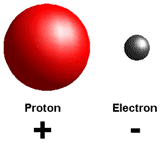 |
Electrons (-) and protons (+) are two particles that have equal
and opposite electrical
charges. Most atoms have the same number of protons and electrons, so they have a neutral (no) charge. Electrons can break free of atoms and move to other objects, leaving a positive charge where the protons remain in place. |
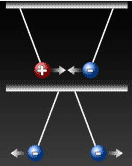 |
Opposite
charges attract. Similar charges repel. |
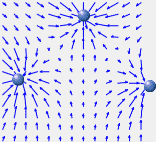 |
Electric
Field is the area around a charged particle where electrical force
can be exerted. Arrows are drawn from the positive charge to the negative charge. Where the lines are densest, the force is strongest, near the charge. |
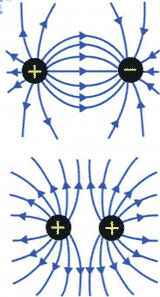 |
Combining fields Filed Lines join together when opposite charges attract. Field lines push and do not join when similar charges repel. |
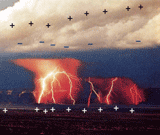 |
Static electricity
is the buildup of charges on an object. Electrons build up in fast
moving air and water droplets during a thunderstorm. Static discharge is the loss of charge. Charges move between two objects until their charges are equal. Lightning is a huge spark that balances a buildup of electrons in the atmosphere. |
 |
Magnets are materials that
attract iron. They can be made out of the elements iron, nickel, cobalt (and less often neodymium & samarium) Lodestones are rocks that contains the mineral magnetite. Materials with iron are called ferromagnetic. |
 |
Magnetic Poles are the
strong ends of a magnet. They always come in North and South pairs. Opposites (N+S) attract, Same (S+S or N+N) repel. The Earth's core is a giant iron magnet making Earth's magnetosphere. |
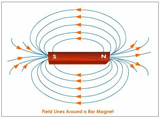 |
Magnetic
Field is the area around a magnet Arrows are drawn from the North pole to the South pole. Where the lines are densest, the force is strongest, like at the poles. |
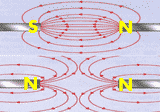 |
Combining fields Filed Lines join together when opposite poles attract. Field lines push and do not join when similar poles repel. |
 |
A compass is a device that points along magnetic field lines towards the north and south poles of a magnet. |
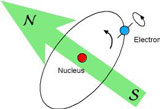 |
Magnetic fields are created by electrons
spinning in the same direction. |
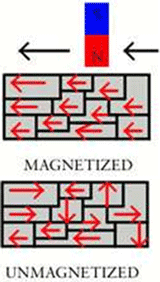 |
Magnetic domains are areas in
which the electrons spin in the same direction. The more electrons are
aligned, the stronger the field. You can make a magnetic domain by rubbing iron with one pole of a magnet to align electrons. You can mess up a magnetic domain by hitting or heating it. An electric current in a coiled wire can also align electrons, making an electromagnet |
 |
Scientist John Clerk Maxwell (1831-1879) developed our unified theory of electricity and magnetism, thus becoming the father of modern physics. |
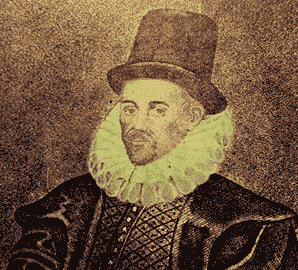 |
Scientist William Gilbert (1544-1603) wrote the book (6-volumes) called Die Magnete on electricity and magnetism setting the words used in the field ever-after. He described his own experiments and new ideas about Earth's magnetic field. |
 |
Technology Electric Motors use magnets and electromagnets to turn spinning sharft that can be used to make motion. |